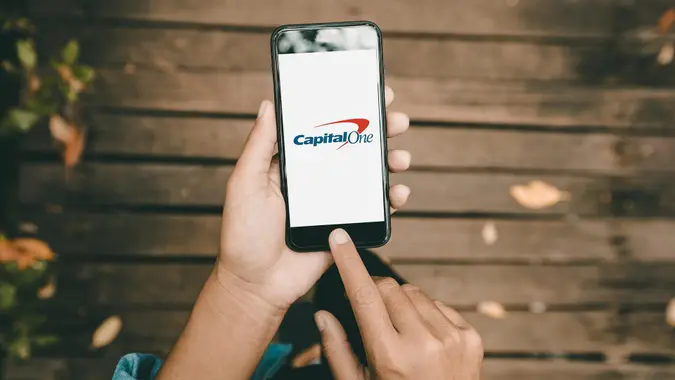What’s an HSA and How Can You Save Money With It?

Commitment to Our Readers
GOBankingRates' editorial team is committed to bringing you unbiased reviews and information. We use data-driven methodologies to evaluate financial products and services - our reviews and ratings are not influenced by advertisers. You can read more about our editorial guidelines and our products and services review methodology.

20 Years
Helping You Live Richer

Reviewed
by Experts

Trusted by
Millions of Readers
A health savings account can offer a break on your taxes while you save money to cover medical expenses. But like other tax-advantaged accounts, HSAs have special eligibility requirements and limits on how much you can contribute.
Keep reading to find out if you qualify for an HSA, and if so, how to get the most value from your account.
What Is a Health Savings Account?
A health savings account, or HSA, is a tax-free savings account that helps eligible individuals pay for qualified medical care. Not only do you put pre-tax money into an HSA, but you can also make tax-free withdrawals — so long as you use the funds for qualified healthcare expenses.
HSAs are only available to individuals and families who have HSA-eligible high-deductible health plans. This is a type of insurance policy that has a higher deductible than standard insurance. That means you have to pay more money out of pocket for any medical costs that are subject to deductibles. In return, you pay lower insurance premiums and can use money from your HSA to cover or offset your deductible and your qualified medical expenses.
You can open an HSA through any bank or investment brokerage that offers the accounts. If you open one with an investment brokerage, you can keep your savings in an interest-bearing cash account. Or, you can choose to invest some or all of it into pre-built robo-portfolios or investments of your own choosing.
Bank HSAs are cash accounts. However, if the bank has an investment partner, you can invest some some your balance — the minimum you need to keep in the cash account varies by bank.
If you have HSA-eligible insurance through your employer, you can contribute through payroll deductions. Also, you can add money, up to IRS limits, through whatever method the bank or investment brokerage makes available — transfers from a linked checking account, for example. Then, when you incur a qualified expense, you have several ways to withdraw money from the account.
How Health Savings Accounts Work
The amount of qualified medical expenses you can pay for with your HSA is limited only by your account balance. Qualified medical expenses include:
- Ambulance transportation
- Dental care
- Diagnostic services and equipment
- Disabled dependent care
- Eye care, including eyeglasses
- Fertility treatment
- Service animals
- Hearing aids
- Home healthcare
- Hospital services
- Long-term care
- Nursing services
- Physical exams
- Psychiatric care
- Select insurance premiums, including long-term care, COBRA, premiums you pay while on unemployment and Medicare and other medical coverage once you turn 65
- Surgeries
- Smoking-cessation programs
- A weight loss program ordered as treatment for a specific disease
Your health savings account provider will send you a debit card you can use to pay these and other qualified medical expenses. You can also pay expenses directly from the account, just like you might pay bills from your checking account. Other ways you might access your funds include transferring money from your HSA to a checking or other payment account, or withdrawing money from an ATM to pay cash or reimburse yourself for HSA-eligible expenses you paid out of pocket.
Good To Know
Verify any expenses before you incur them. If you use the money for non-qualified expenses, you’ll have to claim the amount as income on your tax return. This could incur a 20% tax penalty.
If you expect to have dental or vision expenses, or both, consider opening a limited-purpose flexible savings account to pay those costs. That way, you’ll have more of your HSA funds available for other medical expenses. Along the same lines, a dependent care FSA can pay for disabled dependent care, leaving more of your HSA for other uses, and help compensate for child care costs, which are not HSA-eligible.
Benefits of a Health Savings Account
HSAs offer several benefits, some of which you won’t get with other types of savings accounts.
- If you receive the HSA through your job, your employer can contribute.
- Personal contributions are tax-deductible; payroll deferrals and employer contributions also are not taxed.
- Contributions grow tax-free.
- Withdrawals are tax-free as long as you use them for qualified medical expenses.
- Unused balances roll over from one year to the next — your funds never expire.
- The account is yours, and it remains yours even if you change jobs or health plans.
- When you turn 65, you can make unqualified withdrawals without penalty, although you’ll have to report the income on your tax return.
Who Is Eligible for an HSA?
You should be aware of the eligibility requirements for a health savings account. You may open or contribute, or both, to an HSA only if you meet the following requirements:
- You have an HSA-eligible high-deductible health plan.
- You can’t be claimed as a dependent on someone else’s tax return.
- You don’t have other health coverage, except as permitted by IRS rules.
- You aren’t enrolled in Medicare.
How To Open a Health Savings Account
To establish an HSA, you need to enroll in an HSA-eligible HDHP. After that, follow these steps:
1. Select an HSA Provider
Research accounts from banks, credit unions and investment brokerages to find one that offers easy ways to deposit money and withdraw funds to cover expenses, and that compares favorably in terms of fees and account features.
2. Begin the Enrollment Process
If your HSA is an employee benefit, ask your employer how to enroll. Otherwise, gather the information you’ll need to open your own account. That includes your email address, physical address, phone number, Social Security number and birth date.
3. Fund Your HSA
You’ll need to fund the account once it’s open. If the account is an employee benefit, your employer can make your contributions via pre-tax payroll deductions. If you’re opening the account independently, you can deposit funds directly or transfer money from another account.
Contribution Limits and Rules
Though a savvy way to save for future healthcare costs, an HSA does come with some contribution limitations. Here are some things to consider:
- Those with self-only coverage under an HDHP can contribute a maximum of $4,150 to their HSA in 2024 and $4,300 in 2025.
- Those with family coverage can contribute up to $8,300 in 2024 and $8,550 in 2025. If you have an employer-sponsored account, your employer may match your contributions up to your contribution limit.
- Once you reach age 55, you can make an additional $1,000 in catch-up contributions.
- Tax day is generally your deadline for contributing to your HSA for the previous tax year. For example, to contribute fully to your HSA for the tax year 2024, you need to do so by the federal tax filing deadline of April 15, 2025.
| Coverage Type | 2024 Contribution Limit | 2025 Contribution Limit | Catch-Up Contribution (age 55 and older) |
|---|---|---|---|
| Self-only (HDHP) | $4,150 | $4,300 | $1,000 |
| Family (HDHP) | $8,300 | $8,550 | $1,000 |
In summary:
- Employer contributions count toward your annual limit.
- You have until Tax Day– for example, April 15, 2025, for 2024 contributions — to contribute for the prior tax year.
FAQ
Here are some quick answers to a few common questions about HSAs.- Can I have an HSA and a flexible spending account?
- You can't have an HSA and a standard FSA, but you can combine an HSA with a limited purpose and/or dependent care FSA.
- What happens to my HSA if I switch jobs or health plans?
- The account is still yours, and you can still use it for qualified medical expenses. However, you can't make more contributions unless you still meet the eligibility criteria.
- Are there penalties for using HSA funds for non-medical expenses?
- Yes. In addition to possibly having to pay income tax on the money, you could be hit with a 20% tax penalty.
- Can HSA funds be used for retirement?
- Yes, at age 65. You'll report the income on your tax return, but you can use the money however you want, including for Medicare premiums.
Final Take
High deductibles and out-of-pocket limits can make HDHPs an expensive option if you use a lot of healthcare services. An HSA can help you to offset those costs, making necessary medical care more affordable. However, the many options available to you from banks, credit unions and investment brokerages can make choosing an HSA difficult. Research accounts carefully before selecting the best one to cover your healthcare needs and ensure that you’ll have cash available for other financial goals.
Caitlyn Moorhead and Jessica Moore contributed to the reporting for this article.
This article has been updated with additional reporting since its original publication.
Our in-house research team and on-site financial experts work together to create content that’s accurate, impartial, and up to date. We fact-check every single statistic, quote and fact using trusted primary resources to make sure the information we provide is correct. You can learn more about GOBankingRates’ processes and standards in our editorial policy.
- HealthCare.gov. "Understanding HSA-eligible plans."
- Fidelity. "Did you know you can invest your HSA?"
- Bank of America. "Investing FAQ."
- HSA Bank. "How to use your Health Savings Account."
- IRS. "Publication 969 (2024), Health Savings Accounts and Other Tax-Favored Health Plans."
- IRS. "Medical and Dental Expenses."
- State Savings Bank. "What Happens if I Use my HSA for Other Purposes?"
- FSAFEDS. "The Savings Power of This FSA."
- Fidelity. "HSA contribution limits and eligibility rules for 2024 and 2025."
 Written by
Written by  Edited by
Edited by 

























